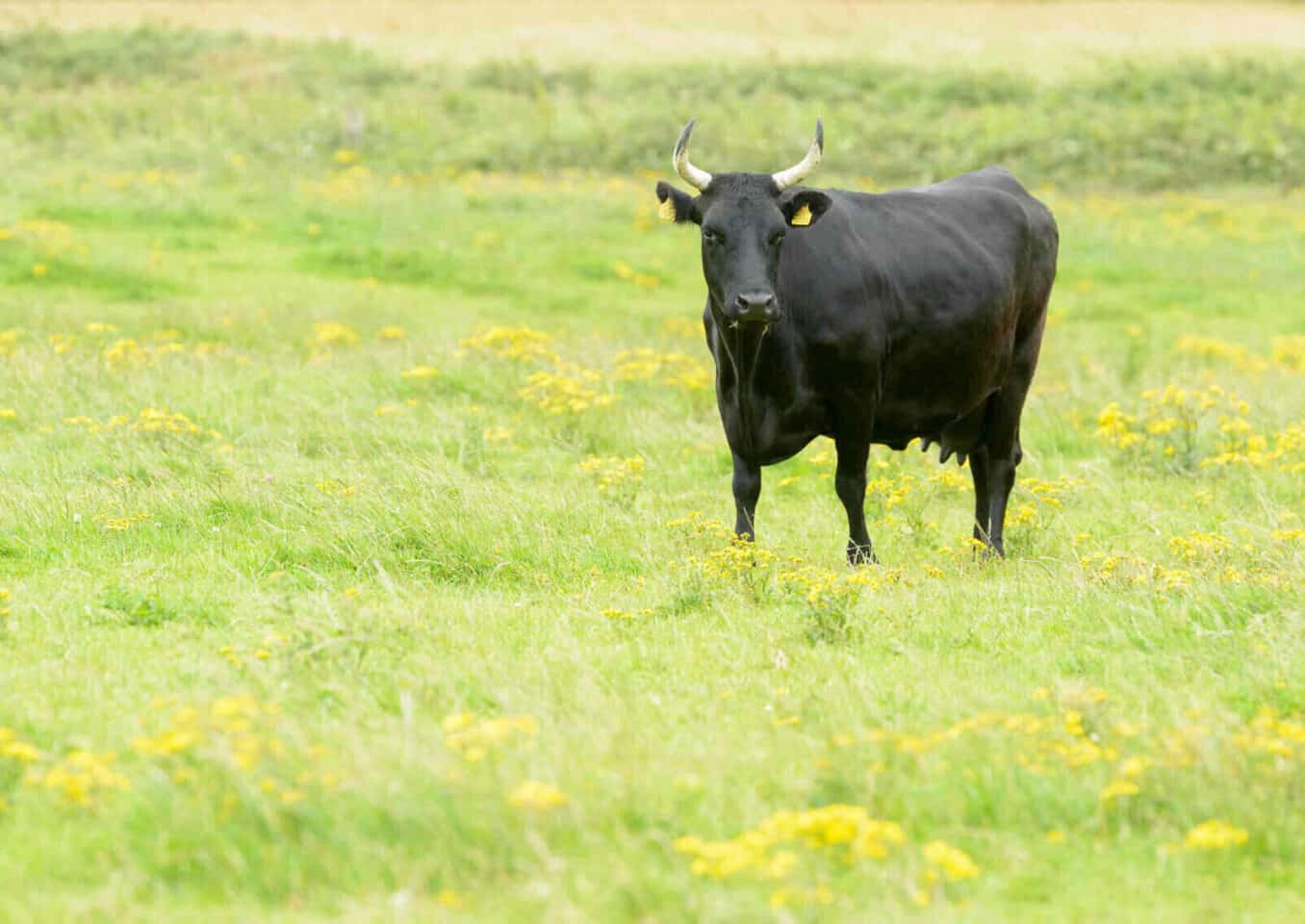The Kerry cattle is one of the oldest known breeds in Europe, and they’ve become a particularly prized breed in Ireland. They’re hardy and adaptable, and they also produce delicious milk. These characteristics, combined with their easy-going personalities, make them beloved by many farmers.
Despite the Kerry cattle’s rarity and small population size, they’re a special breed worth knowing. Here’s all the information you need to start getting acquainted with the Kerry cattle.

Quick Facts About Kerry Cattle Breed
| Breed Name: | Kerry Cattle |
| Place of Origin: | Ireland |
| Uses: | Dairy |
| Bull (Male) Size: | 990 pounds |
| Cow (Female) Size: | 880 pounds |
| Color: | Black |
| Lifespan: | 18–20 years |
| Climate Tolerance: | Cold, wet climate |
| Care Level: | Intermediate |
| Milk Production: | 6,600-8,00 pounds per lactation cycle |
| Rarity: | Very Rare |
Kerry Cattle Origins
Kerry cattle are native to Ireland. They were very prominent and common in Ireland during the late 17th century. However, as more cattle breeds were imported and cross-breeding began, this breed’s population started to decline.
Eventually, Kerry cattle became isolated to southwestern parts of Ireland, and they became common and valuable livestock for poor farmers.
Today, conservation efforts in the UK and the US are working to revive and repopulate this rare cattle breed. The Kerry Cattle Society in Ireland works with breeders in the US to register and conserve this cattle breed.
Kerry Cattle Characteristics
Kerry cattle can technically be a dual-purpose breed because its beef is also delicious and of good quality. However, the breed’s milk definitely overshadows the beef. Since there are other cattle breeds with particularly delicious and marbled beef, Kerry cattle are mainly dairy cattle, and it’s less common to see Kerry cattle beef sold by farmers.
When it comes to temperament, both cows and bulls have docile personalities. They can be very calm and even-tempered. However, they’re also very active cows that enjoy grazing and moving around. Since they’re active, agile, and extremely rare, Kerry cattle do best with intermediate and expert cow farmers.
Kerry cattle are hardy and are familiar with living through cold and wet Irish winters. They can do well in small farm settings since they’re relatively small compared to other cattle breeds. However, they can also enjoy grazing in large areas. They’re also good at converting low-quality forage.
Their small size and agility enable them to navigate rugged terrain easily without causing significant damage as they graze. Since Kerry cattle are more lightweight than other cow breeds, their hooves don’t rough up damp grazing fields.
Kerry Cattle Breed Uses
Kerry cattle were the first cattle breed to get bred exclusively for their milk. They produce high-quality milk that’s great for making cheese, ice cream, and yogurt. In fact, the famous Murphy’s Ice Cream exclusively uses Kerry cattle milk to make their renowned ice cream recipes.
Kerry cattle milk is exceptionally delicious because it contains tiny fat globules smaller than milk from other cattle breeds. This composition makes the milk taste smoother and creamier.
Also, the fat globules are so small that many people who have trouble digesting fat can usually enjoy Kerry cattle milk without experiencing an upset stomach.
Kerry Cattle Breed Appearance & Varieties
Kerry cattle are solid black and can have white around their underside and udders. They have short, white horns with black tips that point upwards. This breed tends to have a smaller and thinner appearance than other cow breeds.
Kerry cattle share a descendant with Dexter cattle. Dexter cattle have more color variance and are stockier than Kerry cattle. However, both cattle breeds are relatively rare, and many cattle breeders are trying to grow their population sizes.
Kerry Cattle Population, Distribution & Habitat
Kerry cattle originated in Ireland. The US imported some of them in the 1800s, but unfortunately, they didn’t quite catch on to become a popular cattle breed in America.
After the Kerry cattle population fell to about 200 in the 1980s, US breeders, Irish breeders, and conservationists started working together to protect this heritage breed.
Today, there are only a few Kerry cattle herds left in the UK and US. Kerry cattle are critically endangered, so many Irish Kerry cattle breeders and conservationists have teamed up with US breeders to bring up the population size.

Are Kerry Cattle Good for Small-Scale Farming?
Kerry cattle are good for small-scale farming for several reasons. First, they’re not picky eaters and can convert poor-quality forage easily. They’re also small and agile, so they don’t cause a lot of damage to land surfaces.
Kerry cows also have an easy time with calving, and they’re also generally hardy. They can live in colder climates and are relatively adaptable.
Overall, Kerry cattle are flexible and healthy. They can be active, but they can also live on smaller farms because of their small size.
Kerry cattle are an endangered breed, yet they provide so much for people. They’re docile and adapt well to many different settings, and they also produce some of the most delicious dairy milk.
Fortunately, breeders and conservations in the US and UK have teamed up to protect this breed and regrow the population. The future’s looking brighter for Kerry cattle, and hopefully, they’ll become a more common sight to see in the years to come.
Featured Image Credit: AndreAnita, Shutterstock
